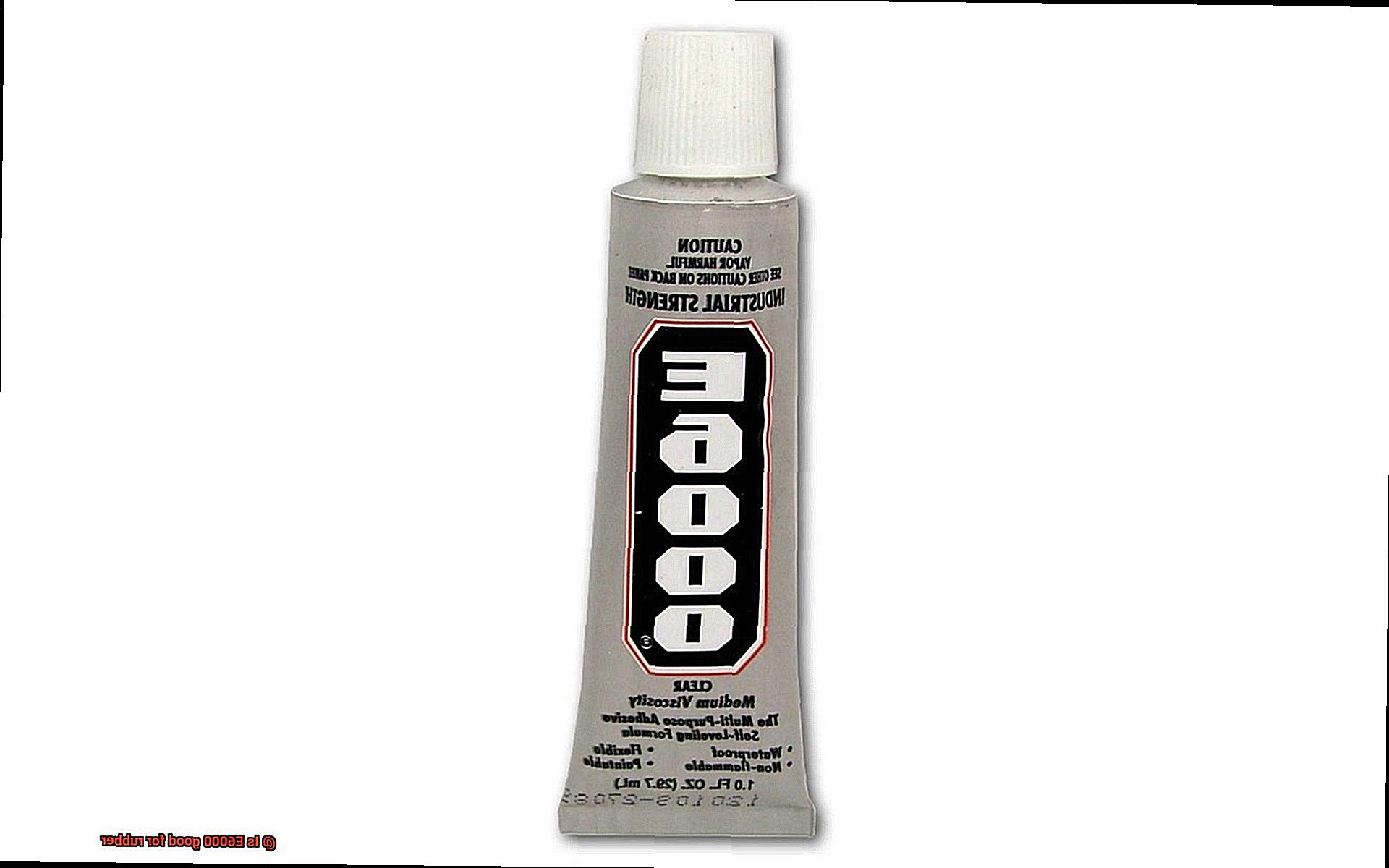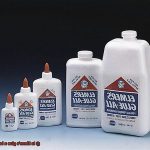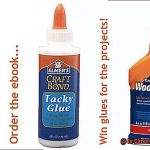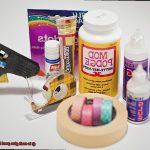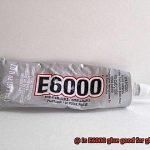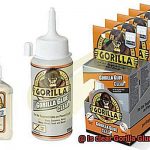Working with rubber can be a real head-scratcher. Finding an adhesive that not only sticks like glue but also withstands the demands of this stretchy material is no easy feat. But fear not, my fellow rubber aficionados. Enter E6000 DIY adhesive, the superhero of rubber bonding.
E6000 has earned its stripes in the crafting and repair world for its unmatched versatility and reliable performance. But what sets it apart when it comes to rubber? Prepare to be captivated as we delve into the extraordinary benefits of E6000 and uncover why it’s the go-to adhesive for both hobbyists and professionals.
Join me on this journey as we unravel the secrets behind E6000’s remarkable compatibility with rubber. We’ll explore its sheer strength, flexibility, and durability – qualities that make it an indispensable companion for any DIY project or complex repair. With E6000 by your side, you can rest assured knowing your bond will stand the test of time.
So sit back, relax, and get ready to discover the hidden gems of E6000 adhesive – your ultimate ally in the realm of rubber bonding.
What is E6000?
Contents
E6000 is not your average adhesive. It is a force to be reckoned with, a powerhouse of strength and durability that is highly sought after for its exceptional bonding capabilities. This adhesive has a knack for creating unbreakable connections, making it the go-to choice for applications where a secure and long-lasting bond is essential.
But E6000 doesn’t stop at strength alone. It offers a flexibility that is unparalleled, allowing it to move and bend with the materials it bonds. Whether you’re working with rubber, which demands a little give, or any other flexible material, E6000 ensures that the bond remains intact even in the face of movement and stretching.
And let’s talk about its resilience. E6000 laughs in the face of water and extreme temperatures. It is waterproof and heat resistant, making it the perfect companion for both indoor and outdoor projects. No need to worry about your hard work being compromised by exposure to water, humidity, or scorching temperatures – E6000 has got you covered.

However, this adhesive does come with a caveat – its strong odor. The volatile organic compounds (VOCs) present in E6000 give it a distinct smell that can be overpowering. To avoid any unpleasant experiences, it’s best to use this adhesive in a well-ventilated area or don a mask to reduce exposure to the fumes.
Now, if you’re specifically looking to use E6000 on rubber, there are a few things you should keep in mind. Firstly, proper surface preparation is key. Clean that rubber surface thoroughly before applying E6000 for optimal adhesion. Secondly, while E6000 can successfully bond some types of rubber, it’s always wise to test it on a small, inconspicuous area first to ensure compatibility and effectiveness. And finally, remember that E6000 may not be the ultimate choice for applications where water resistance is crucial. While it offers a range of fantastic qualities, waterproof capabilities are not its defining feature.
Why is E6000 Popular?
E6000 adhesive has gained incredible popularity among crafters and DIYers for a multitude of reasons. Its versatility alone sets it apart from other adhesives on the market. E6000 can bond rubber to various surfaces, including metal, glass, wood, plastic, fabric, and more. This extensive compatibility makes it an ideal choice for a wide range of projects and applications, from jewelry making to repairing household items.
The exceptional adhesion properties of E6000 further contribute to its popularity. It creates a strong and long-lasting bond that can withstand both indoor and outdoor conditions. This durability is particularly crucial for projects that require a secure hold, such as attaching rubber soles to shoes or bonding rubber gaskets in plumbing applications.
E6000 adhesive is not only resistant to water, chemicals, and extreme temperatures but also remains flexible once cured. This flexibility allows it to move with the bonded materials without cracking or losing its bond strength. For instance, when using E6000 to attach rubber trim to a car door, the adhesive will withstand the opening and closing of the door without compromising the bond.
Ease of use is yet another factor that contributes to the popularity of E6000. The adhesive comes in a convenient tube with a nozzle for precise application. Its thick consistency prevents it from running or dripping, ensuring that it stays in place during the bonding process.
Furthermore, E6000 has a relatively quick drying time compared to other adhesives. While the exact drying time may vary depending on factors like temperature and humidity, it typically dries within 24 hours. This allows users to continue working on their projects without significant delays.
The clear and transparent finish that E6000 cures into is also appealing to many crafters and DIYers. It does not leave any visible residue or marks on the surfaces it bonds, making it suitable for applications where aesthetics are important.
The reliability and durability of E6000 have been widely praised by professionals and hobbyists alike. Many users have reported that their projects bonded with E6000 have held up well over time, even under heavy use or stress. This assurance of quality has made E6000 a trusted adhesive in the crafting and DIY community.
Lastly, the availability of E6000 in various sizes and packaging options caters to the needs of different users. Whether someone needs a small tube for individual projects or a larger container for bulk applications, E6000 offers choices to accommodate various requirements.
Advantages of Using E6000 on Rubber
The use of E6000 adhesive on rubber offers a multitude of advantages that make it an excellent choice for bonding rubber materials effectively and reliably.
Firstly, E6000 adhesive creates a strong and durable bond on rubber. This high-performance industrial-strength adhesive ensures that the materials stay securely attached even under significant stress and strain.
Additionally, E6000 is highly versatile, compatible with various types of rubber such as natural rubber, neoprene, and silicone rubber. This versatility makes it suitable for bonding a wide range of rubber-based products including shoes, gaskets, and seals.
Furthermore, E6000 is known for its flexibility, allowing it to withstand movement and flexibility without compromising the bond. It can easily withstand bending, stretching, and twisting without losing its grip on the rubber surface.
Moreover, E6000 exhibits excellent resistance to water and weather. It is water-resistant and can provide reliable bonding even in wet or damp environments. It also has exceptional resistance to temperature changes, making it suitable for both indoor and outdoor applications.
Another advantage of using E6000 on rubber is its chemical resistance. It can withstand exposure to common household chemicals and industrial solvents without weakening or breaking down the bond.
The application of E6000 is also user-friendly. It comes in a convenient tube with a precise applicator tip, making it easy to apply without any mess or waste. The adhesive has a thick consistency that prevents dripping or running during the bonding process.
Lastly, E6000 is widely used in industrial and professional settings due to its professional-grade strength and reliability. It meets the high standards of various industries, making it an ideal choice for bonding rubber materials effectively.
Limitations of Using E6000 on Rubber
E6000 adhesive is a versatile and strong adhesive that has gained popularity in various industries. However, when it comes to using E6000 on rubber materials, there are several limitations to consider.
Firstly, rubber materials have a low surface energy, which makes it difficult for adhesives to properly bond with them. While E6000 provides a strong bond on many surfaces, it may not provide the same level of adhesion on rubber materials. This can result in a weaker bond and a higher chance of the adhesive eventually peeling off.
Another limitation of using E6000 on rubber is its flexibility. Rubber materials often require flexibility to maintain their functionality, especially in applications such as footwear or rubber seals. While E6000 is somewhat flexible, it may not be able to provide the same level of flexibility as specific rubber adhesives that are designed for this purpose. This can lead to the adhesive becoming brittle over time and eventually cracking or breaking under stress.
Chemical compatibility is also an important consideration when using E6000 on rubber. E6000 is not resistant to certain chemicals and solvents that are commonly found in rubber materials. These chemicals can cause the adhesive to break down or weaken, resulting in a loss of adhesion. It is crucial to consider the specific chemicals that will come into contact with the adhesive and choose an appropriate adhesive that is compatible with those chemicals.
Furthermore, temperature sensitivity is another limitation of using E6000 on rubber. Extreme temperatures can impact the performance of the adhesive. Rubber materials are often exposed to a wide range of temperatures, especially in outdoor applications. Therefore, it is essential to ensure that the adhesive being used is capable of withstanding these temperature fluctuations without compromising its bond strength.
How to Prepare the Surface for Bonding with E6000
To prepare the surface for bonding with E6000 adhesive, there are several important steps to follow. First, it is crucial to clean the surface thoroughly. Use a mild detergent and warm water to remove any dirt, dust, or oils that may be present. Scrub gently with a soft brush or sponge to ensure all contaminants are removed. Rinse the surface with clean water and make sure it is completely dry before moving on to the next step.
Next, if the surface is smooth or glossy, such as rubber, it may be necessary to roughen it up slightly. This can be done using sandpaper or a sanding block with a medium-grit. Gently create a rough texture on the surface, being careful not to remove too much material. This roughened surface will provide better adhesion for the E6000 adhesive.
After roughening the surface, it is important to remove any dust or debris that may be present. Wipe away any particles using a clean cloth or use compressed air to blow them off. This will ensure that the surface is clean and ready for bonding.
In some cases, a primer may be necessary before applying the E6000 adhesive. Follow the instructions provided by the manufacturer to apply a thin layer of primer onto the surface and allow it to dry completely. The primer helps improve adhesion and creates a suitable surface for the glue to bond with.
Finally, apply the E6000 adhesive using a brush or an applicator. It is best to apply a thin layer of glue to both surfaces that you want to bond together. Make sure to spread the glue evenly over the surfaces to ensure a strong bond.
Allow the adhesive to become tacky before pressing the surfaces together. Letting the adhesive sit for a few minutes will help improve bonding. The drying time may vary depending on factors such as temperature and humidity, so it is important to follow the manufacturer’s instructions.
Once the adhesive is tacky, carefully align the two surfaces and press them together firmly. Apply even pressure and use clamps or other tools if necessary to hold the surfaces in place until the glue sets completely.
Temperature Resistance of E6000
E6000’s temperature resistance is one of its standout features, making it an ideal adhesive for rubber applications. Whether you’re working in scorching heat or freezing cold, E6000 remains stable and maintains its bonding properties.
In hot weather, E6000 doesn’t soften or lose its adhesive properties. This is especially crucial for outdoor applications or automotive repairs where rubber materials may be exposed to direct sunlight or high temperatures. Picture sealing rubber gaskets on outdoor equipment or securing rubber trim on vehicles without worrying about the bond weakening.
Similarly, in cold weather, E6000 retains its flexibility and adhesion strength. It’s like a superhero for rubber materials needing to withstand freezing temperatures without becoming brittle or losing their bond. Imagine repairing the worn-out rubber soles on your favorite winter boots or sealing rubber seals in refrigeration units with confidence.
However, it’s worth noting that while E6000 can handle a wide temperature range, it does have its limits. If the temperature exceeds 180°F (82°C), the adhesive may start to soften and lose effectiveness. Likewise, at temperatures below -40°F (-40°C), the adhesive may become too hard and lose its flexibility.
To ensure optimal performance, proper surface preparation is key when using E6000 on rubber surfaces. Make sure the material is clean and free from any contaminants like oil or grease. This will enhance the adhesive’s performance and help achieve a strong bond.
Additionally, following the manufacturer’s instructions regarding application and curing time is crucial for optimal strength. E6000 typically requires a curing period of 24 to 72 hours, depending on the temperature and humidity conditions.
Waterproof Properties of E6000
The waterproof properties of E6000 are a crucial consideration for those using it on rubber materials. Although not specifically formulated for rubber, this adhesive can still offer a dependable waterproof seal in many instances. However, it is important to note that its effectiveness may vary depending on the type of rubber being used.
To achieve a strong and waterproof bond, proper surface preparation is essential. Thoroughly cleaning the rubber surface to remove any dirt, dust, or grease that could hinder adhesion is crucial. Additionally, roughening the surface slightly with sandpaper or another abrasive material can enhance the bond.
After application, the adhesive needs sufficient curing time to reach its maximum strength and waterproof properties. Following the manufacturer’s instructions regarding drying and curing times is imperative for optimal results.
In most cases, E6000 provides a durable and waterproof bond on rubber materials. However, it is essential to consider the specific conditions to which the adhesive will be exposed. Prolonged exposure to water or extreme conditions may impact the longevity of the bond. Regular maintenance and care may be necessary to ensure the adhesive remains intact over time.
If a more specialized waterproof solution is required for rubber materials, alternative adhesives formulated specifically for this purpose are available in the market. Consulting with a professional or reading product labels can provide guidance on selecting the best adhesive for specific rubber applications.
Testing the Adhesive Before Use
Testing the adhesive before use is an essential step when working with E6000 adhesive on rubber surfaces. By conducting this test, you can ensure compatibility and effectiveness, avoiding any potential damage or failure of the adhesive. Here are some key reasons why testing is important:
Firstly, compatibility is crucial. Not all rubbers are created equal, and different types of rubber may react differently to adhesives. By testing the E6000 adhesive on a small inconspicuous area of the rubber surface, you can determine if the adhesive is compatible with that specific type of rubber.
Secondly, adhesion strength must be evaluated. Testing allows you to assess how well the E6000 adhesive bonds to the rubber surface. After the curing time, inspect the test area for any signs of lifting, peeling, or weakening of the adhesive bond. This helps ensure that the adhesive will securely bond to the rubber without any issues.
Thirdly, proper surface preparation is key. Before conducting the test, clean the selected area thoroughly with soap and water and then dry it completely. This removes any dirt, dust, or oils on the surface that could affect adhesion. The test also provides an opportunity to assess if the surface preparation is sufficient for achieving a strong bond.
Moreover, environmental factors play a role in adhesive performance. Temperature and humidity can impact how well adhesives work. By testing the E6000 adhesive under normal or anticipated environmental conditions, you can evaluate its effectiveness in those specific conditions. Extreme temperatures or high levels of moisture can influence adhesive performance.
Lastly, safety is paramount. Testing the adhesive before use ensures safety by preventing any unwanted damage or failure. If there are any signs of failure or damage during the test, it is recommended not to use E6000 on that specific rubber surface. This helps avoid potential hazards or accidents caused by an ineffective bond.
b2Dd2_BjEWY” >
Conclusion
In conclusion, E6000 adhesive reigns supreme when it comes to bonding rubber materials. Its unrivaled strength, flexibility, and durability make it the adhesive of choice for both amateurs and experts alike.
When it comes to rubber, E6000 delivers a bond that stands the test of time. It remains flexible even after curing, allowing it to twist and turn with the rubber without compromising its grip. This is particularly crucial for applications where the rubber needs to maintain its functionality, such as footwear or rubber seals.
But that’s not all – E6000 also boasts resistance against water, chemicals, and extreme temperatures. It fearlessly tackles wet or damp environments while withstanding temperature fluctuations like a champ. Whether your project is indoors or outdoors, E6000 has got your back.
The cherry on top? E6000 is a dream to use. Its easy application process and quick drying time ensure a hassle-free experience. And let’s not forget about its clear finish – no unsightly residue here. Users rave about how their projects bonded with E6000 have endured heavy use and stress over time.
However, before you dive headfirst into an E6000-rubber love affair, there are some limitations to consider. Rubber surfaces have low surface energy, which can impact adhesion strength. Additionally, specific rubber adhesives may offer superior flexibility or chemical resistance for certain applications.
To unlock the full potential of E6000 on rubber surfaces, proper preparation is key. Thoroughly cleaning the surface and giving it a slight roughening will enhance adhesion like never before. And don’t forget to conduct a compatibility test on a small inconspicuous area before going all-in.
All in all, when it comes down to bonding rubber materials effectively and reliably, E6000 adhesive is your knight in shining armor. Its versatility, strength, and durability make it an indispensable tool in the world of rubber bonding.

